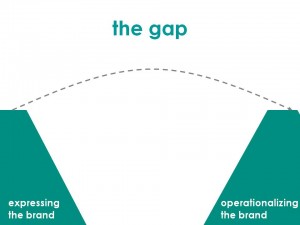why not operationalize brands? part 1
Over coffee the other day a colleague asked me a question I actually get asked a lot: Do you find that people “get it?” By “it” he was referring to operationalizing the brand, the approach I teach and help my clients implement. He asked because he’s found, as have I, that although many company leaders claim to understand the difference between expressing and operationalizing a brand, the fact is, most don’t put their brand in the driver’s seat of their organization.
Our talk prompted me to think about why this is the case. Most business leaders are eager to leverage the full potential of their brands, but they’re not following through.
I concluded that most are held back by holes in their experience, roadblocks in their organizations, or their own blinders. I would say business leaders fall into one of three categories when it comes to the subject of operationalizing their brands. (In today’s post, I’ll outline the first two, and later this week, I’ll conclude with the third.)
Naives. Some business leaders can be described as “Naive” — those who think of brands only in literal terms. To Naives, a brand is simply a logo or perhaps at most an advertising campaign.
The buzz that brands have received in recent years has piqued the interest of Naives but they’ve been misled by misinformation from so-called experts. Many agencies, consultants, and even authors talk about “branding” in terms of slapping the company logo on everything, or using a particular color or tagline consistently, or working the social media circuit. As a result, after researching how to build their brand, Naives usually end up with a long list of things they think they should be doing, but they remain unconvinced that any of them are going to have an impact on their bottom line.
Not surprisingly, executives with technical or financial backgrounds usually fall into this group. In these leaders’ experience, brand development has usually been something relegated to the marketing department — so their exposure to what a brand really is and how to use it properly has been limited.
Salespeople are also often Naives, because of their relentless focus on the sale. Brands may serve as fodder for a great sales presentation, many salespeople believe, but they’re unsure of their value beyond that. And leaders of B2B and technology companies may not recognize how a strong brand can impact their relationship- or innovation-based business models.
Naives simply do not understand the full potential of their brand. That the brand is the core of the company is a foreign concept to these business leaders. They don’t know what they don’t know.
In order for Naives to operationalize their brands, they need to learn to think about brands differently. An open mind and a willingness to test a new approach are the required first steps for these folks.
Aspirers. Another category of business leaders are “Aspirers.” These people are knowledgeable about brands and definitely interested in leveraging them more broadly and substantially, but they don’t know how or they’ve run into roadblocks in their efforts to do so.
A typical Aspirer is a former Chief Marketing Officer who has taken on line operating responsibilities – a common occurrence at packaged goods companies. Having worked with brands throughout their careers, these Aspirers see the potential brands have for creating value throughout the organization but they lack the internal traction to implement the brand-driven approach.
Other Aspirers may have previously worked at or heard about other companies which have opertionalized their brands and are interested in engaging a similar one in their organization.
For Aspirers the key needs are instruction and equipping. They need to learn the specific tools and methodologies and examples which make a solid business case for operationalizing the brand. They need help in conveying the importance of the brand to every stakeholder of their organization and persuading them to adopt the brand as the driver of the business.
I hope this has provided some good food for thought so far. Please check back on Thursday for my description of the final group of business leaders who aren’t operationalizing their brands.
related posts:
